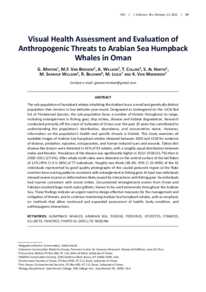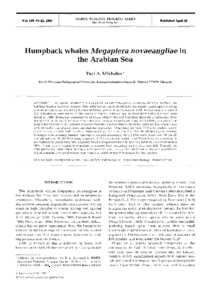Document
Visual health assessment and evaluation of anthropogenic threats to Arabian Sea humpback whales in Oman.
Identifier
DOI: 10.47536/jcrm.v23i1.336
Source
Journal of Cetacean Research and Management. v. 23, 1, p. 59-79
Contributors
van Bressem, M. F., Author
Willson, A., Author
Collins, T., Author
Al-Harthi, S., Author
Willson, M. Sarrouf., Author
Baldwin, R., Author
Leslie, M., Author
Van Waerebeek, K., Author
Country
England.
Publisher
International Whaling Commission
Gregorian
2022-01-01
Language
English
Subject
English abstract
The sub‐population of humpback whales inhabiting the Arabian Sea is a small and genetically distinct population that remains in low latitudes year‐round. Designated as Endangered on the IUCN Red list of Threatened Species, the sub‐population faces a number of threats throughout its range, including entanglement in fishing gear, ship strikes, disease and habitat degradation. Research conducted primarily off the coast of Sultanate of Oman over the past 20 years has contributed to understanding the population’s distribution, abundance, and conservation status. However, information on the population’s health and specific threats is limited. This study examines all available images of Arabian Sea humpback whales obtained between 2000 and 2018 for evidence of disease, predation, epizoites, ectoparasites, and human‐induced scars and wounds. Tattoo skin disease‐like lesions were detected in 41% of 93 whales, with a roughly equal distribution between males and females. Prevalence of the disease was significantly higher in 2012–2018 (51.7%) than in 2000–2011 (27.6%). Killer whale tooth rakes were detected on the ventral surface of the tail flukes of 12% (95% CI 4.5–18%) of 77 individuals. Roughly two thirds (66.6%: 95% CI 52–80%) of the 42 individuals represented by good quality photographs of the caudal peduncle region at the fluke insertion bore scarring patterns consistent with entanglement in fishing gear. At least two individuals showed severe injuries or deformations likely caused by interactions with fishing gear. Six individuals had injuries consistent with vessel strikes. Documented entanglement events from Oman and Pakistan involved large‐mesh nylon gillnets, known to be used extensively throughout the Arabian Sea. These findings indicate an urgent need to design effective measures for the management and mitigation of threats, and to continue monitoring Arabian Sea humpback whales, with an emphasis on methods that allow continued and expanded assessment of health, body condition, and anthropogenic interactions.
ISSN
1561-0713
Category
Journal articles


